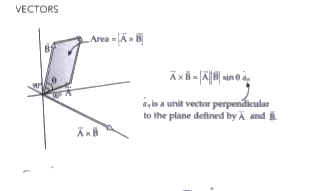If vec(a) is a vector and x is a non-zero scalar, then
x →a is a vector in the direction of →a
x →a is a vector collinear to →a
x →a and →a have independent directions
None of these
The correct Answer is:A, B
Step by step video, text & image solution for If vec(a) is a vector and x is a non-zero scalar, then by Physics experts to help you in doubts & scoring excellent marks in Class 11 exams.
Topper's Solved these Questions
- BOOK - ALLENCHAPTER - MISCELLANEOUSEXERCISE - Exercise-031videos
MISCELLANEOUS
- BOOK - ALLENCHAPTER - MISCELLANEOUSEXERCISE - Exercise-041videos
MISCELLANEOUS
- BOOK - ALLENCHAPTER - MISCELLANEOUSEXERCISE - Exersice -05(B)20videos
MISCELLANEOUS
- BOOK - ALLENCHAPTER - KINEMATICS (MOTION ALONG A STRAIGHT LINE AND MOTION IN A PLANE)EXERCISE - BEGINNER S BOX-78videos
KINEMATICS (MOTION ALONG A STRAIGHT LINE AND MOTION IN A PLANE)
- BOOK - ALLENCHAPTER - PHYSICAL WORLD, UNITS AND DIMENSIONS & ERRORS IN MEASUREMENT EXERCISE - EXERCISE-IV8videos
PHYSICAL WORLD, UNITS AND DIMENSIONS & ERRORS IN MEASUREMENT
Similar Questions
Knowledge Check
- Question 1 - Select One
If ¯a is a non-zero vector of modulus a and m is non-zero scalar, then m¯a is a unit vector, if
Am=±1Ba=|m|Ca=1|m|Dm=1|¯a| - Question 2 - Select One
If ¯a is a non-zero vector of modulus a and m is non-zero scalar, then m¯a is a unit vector, if
Am=±1Bm=|¯a|Cm=1|¯a|Dm=±2 - Question 3 - Select One
If ¯a is a non-zero vector and k is a scalar such that |k¯a|=1, then k=
A|¯a|B1C1|¯a|D±1|¯a|
Let →abe a unit vector and →ba non-zero vector not parallel to →a The angles of the triangle, two of whose sides are represented by √3(→a×→b)and(→b−(→a.→b)→a are
View SolutionIf →c is a given non-zero scalar, and →Aand→B are given non-zero vector such that →A⊥B, then find vector →X which satisfies the equation →A.→Xand→A×→X=→B.
View SolutionIf →a is perpendicular to →b and p is non zero scalar such that p¯r+(¯r.¯b)¯a=¯c
View SolutionIf →a is a non-zero vector of modulus a and λ is a non-zero scalar and λ→a is a unit vector, then
View SolutionThe cross product of two vectors gives a vector perpendicular to the plane containing the vectors.

If →a and →b are non-zero vectors, then →a⋅(→a×→b)= _________View Solution

